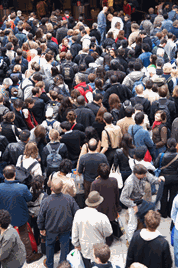 Read the peer reviews for this feature.
Read the peer reviews for this feature.
Download the graphs for this feature.
Changes are taking place in the way people travel. And although we can identify some contributory factors, it is too soon to predict how durable those trends will be. A levelling-off of average car miles per person until 2013 has been matched in 2013-14 by a 5.31% increase in rail passenger journeys, which have more than doubled since privatisation. There has also been a modest increase in cycling (12%) over the past ten years.
A downturn in car use began before the recession, and many reasons have been suggested: the end of the company car as a perk; fewer parking places; improved alternatives; having children later; health concerns encouraging active travel (cycling and walking).
But it is among the millennial generation (those born between the early 1980s and early 2000s) that the change is most pronounced, with the cost of learning to drive, high vehicle insurance costs, student debt, alternative consumer preferences, a propensity to live in urban areas and the importance attached to fitness among the reasons behind it.
Since 1992-94, the number of driving licence holders in the 17-20 and 21-29 age brackets has declined from 48% to 29% and 75% to 63% respectively. Indifference to the car as a status symbol may stem from economic reality, although a similar story can be found in affluent Switzerland, where only 59% of those aged 18-24 have a driving licence. There is also some evidence that those who learn to drive later tend to drive less.
The flipside is a much greater willingness to embrace multimodality, and to choose the optimum mode (or combination of them) for each journey. This is helped by the host of websites and apps providing unprecedented guidance and booking opportunities, in tune with the way younger generations think and live their lives.
Of course, railway travel has always been multimodal. But the trend emphasises the importance of the forgotten Holy Grail of rigorous integration - as exemplified by the SwissTravelSystem, not only in its dovetailed services, but the meticulously detailed travel plans on its website.
Payment systems also need to be developed to cater for multimodal journeys. Perhaps the most all-embracing is the Mobility Mixx card in the Netherlands, which can be used to pay for all public transport, taxis, car pool, bike and car rental, and Park & Ride tickets.
A combination of economic and social circumstances has encouraged these changes among young adults. But how can modal change be effected among the rest of us? The premise behind the question is naturally that any rational policy or credible climate-change mitigation measures must encourage greater use of benign and less-damaging modes of transport… and discourage the worst.
Habits inhibit rational choices, and are coloured by perceptions rather than facts. Deterioration in a chosen option or improvements in the alternatives may not be sufficient to break a habitual pattern, even when congestion makes a journey by car significantly longer than the public transport equivalent. This can go hand-in-hand with a tendency to over-estimate journey time by public transport, and under-estimate the time spent driving.
One of the most revealing (if unsurprising) findings of a number of transport studies is that one of the most likely moments to influence travel behaviour is a change in personal circumstances, whether it be moving home or place of work. Awareness of this opportunity to break a habit prompted the city of Salzburg to provide new residents with a comprehensive information package about its S-Bahn services, and a gift coupon for public transport tickets. It is currently being rolled out to other regions in Austria.
Habit-breaking initiatives
Among some groups, a leaning towards car use can reflect socially induced attitudes and an association of car with status - immigrants have been known to hire a car for a photograph of the family, to show they had ‘arrived’. As another put it: “I haven’t come from Pakistan to ride a bicycle.” However, immigrant households tend to use the car less than the indigenous average of that household type.
Such mindsets are a challenge, although there have been successful habit-breaking initiatives. The University of California offered a free 12-week public transport pass for all employees who handed in their parking pass for that period. After this trial period, the 381 participating employees were offered their parking passes back, or the opportunity to purchase public transport passes at half-price - 70% continued to use public transport, having familiarised themselves with routes and schedules and finding travelling by bus to be less stressful than driving.
Changing travel behaviour requires complementary policies of carrot and stick, ‘pull’ and ‘push’ mechanisms. The Happiness Research Institute in Copenhagen says “the challenge becomes inducing people to act in certain ways without forcing them to do so”, but there is plenty of evidence to suggest that a combination of push and pull measures (restrictive and enhancing interventions) are necessary to accelerate significant results. Broadly speaking, ‘pull’ mechanisms are in the hands of transport providers and ‘push’ in the domain of both central and local government, so understanding pull factors helps the railway industry focus both hard and soft investment.
The pull factors are the positive attributes attached to a mode, and there is no doubt that the quality of many of the pull factors on Britain’s trains and stations has improved significantly over the past two decades.











